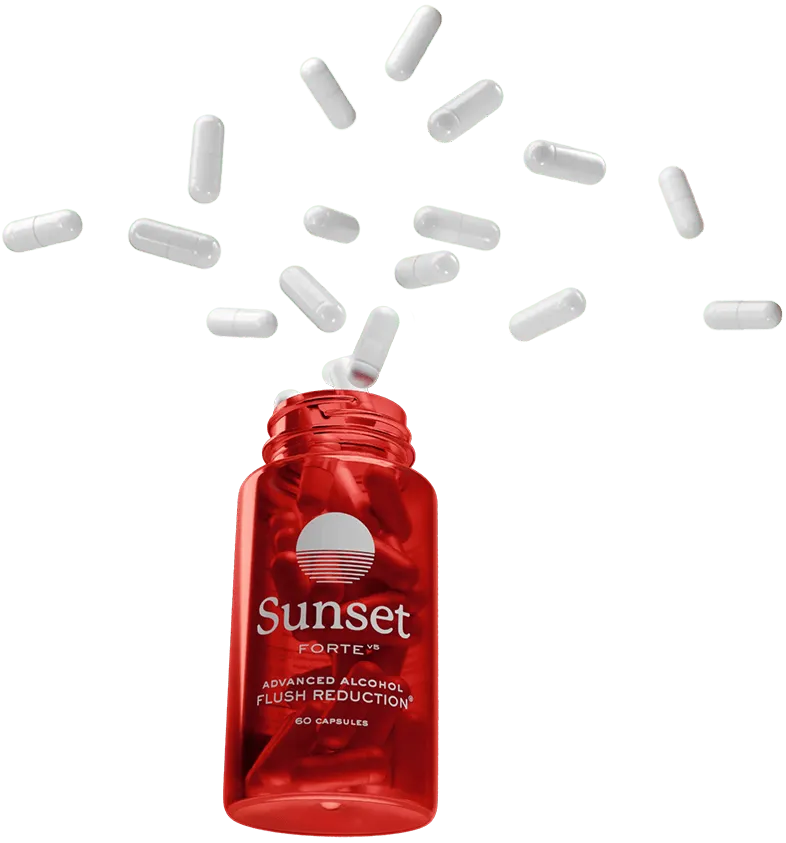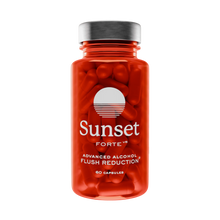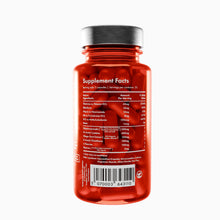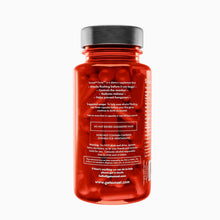Alcohol Flush Reaction Cancer Risk: Is Asian Glow Dangerous Long Term?

⏱️ TL:DR ∙ Article in 20s
Studies show Asian flush sufferers have a substantially higher risk of esophageal cancer due to accumulation of the carcinogenic byproduct acetaldehyde from alcohol. Though abstaining from alcohol is ideal, taking supplements with NAC and S-Acetyl Glutathione can help protect the body for those who still wish to occasionally drink. Using solutions to alleviate Asian flush symptoms allows continued drinking while mitigating cancer risks. See our favourite supplement to metabolize acetaldehyde here.
- Alcohol Flush reaction: science and risks
- Acetaldehyde buildup and cancer risk
- Science behind cancer risk
- Managing your risks for cancer
Share this article
Copy and paste this link
That glow after a few drinks may seem harmless, but emerging research reveals an unsettling connection between Asian flush and cancer risk. If you get a red face after drinking alcohol, it's wise to understand exactly what's going on and how it may affect your health in the long run.
So, are the claims of a potential Asian flush cancer risk actually real? Or are they just another example of one of a myriad of false claims linking things to cancer?
Unfortunately, in this case, the claims are very real. People with genetic ALDH2 deficiency (i.e. Asian flush) have been shown to have a higher chance of getting certain cancers, particularly of the esophagus. To counteract the harmful effects of alcohol flush, you can take Asian flush pills.
More on that later. First, let's take a deep look at the data supporting the Asian flush reaction cancer risk.
A Deep Look at the Science Behind Alcohol Flush Reaction Cancer Risk Claims
So, what does the science say about the alcohol flush reaction cancer risk?
In 1996, a Japanese study looked at the link between Asian flush and esophageal cancer - a type of cancer that is commonly seen in heavy alcohol consumers. They tested groups of alcoholic and non-alcoholic subjects who flush from alcohol and compared them to their respective control groups.

The results showed that the increased risk of esophageal cancer in subjects with Asian flush was “substantially higher” in both alcoholics and non-alcoholics as compared to their respective control groups.
In the words of the researchers:
"The results strongly suggest that because persons who have this mutant ALDH2*2 allele have a high concentration of blood acetaldehyde after drinking alcohol, acetaldehyde (a recognized animal carcinogen) plays a pivotal role in the pathogenesis of alcohol-related esophageal cancer in humans."
Simply put, they suggested that because people with Asian flush accumulate a lot of a toxin called acetaldehyde in their system after drinking alcohol, there might be a link between this toxin and the formation of alcohol-related esophageal cancer.
To understand this further we need to take a closer look at the toxin the researchers are talking about - i.e. acetaldehyde.
The Asian Flush Cancer risk is Associated With Acetaldehyde Buildup
Now that you know yes - Asian glow is dangerous in the long term - let's examine exactly what causes the Asian flush cancer risk.
In our blog post titled The Ultimate Guide to Asian Flush and Asian Glow, we explained how Asian flush is caused by a failure to break down one of the toxic by-products of alcohol metabolism called acetaldehyde. This results in a toxic buildup and in turn cause uncomfortable side effects such as a red face and increased cancer risks.
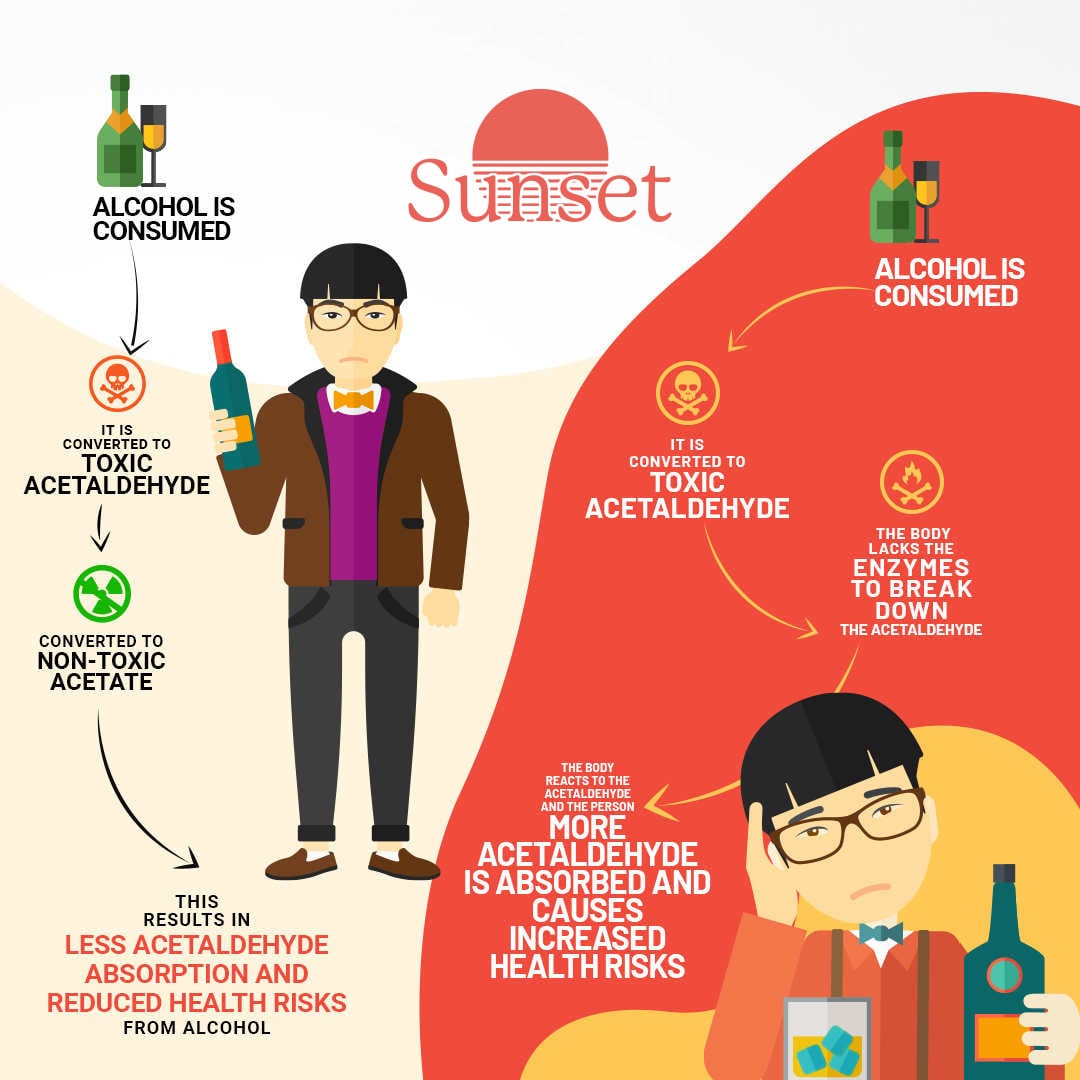
However, according to what these Japanese scientists are suggesting, the red face caused by acetaldehyde is merely a cosmetic problem that accompanies a more serious danger - its carcinogenicity.
In 2009 scientists from the National Institute on Alcohol Abuse and Alcoholism (NIAAA) and Japan's Kurihama Alcohol Center teamed up in a study examining the seriousness of acetaldehyde buildup in Asian flush sufferers and assessing the credibility of claims linking it to heightened esophageal cancer risk.
The results of this review eventually made their way to the National Institute of Health in the United States and eventually to the broader public via a media release dated March 23, 2009.
In this review, the NIH stated:
“…individuals with one copy of the inactive variant are about 6-10 times more likely to develop esophageal cancer than are individuals with the fully active ALDH2 enzyme who drink comparable amounts of alcohol. Notably … individuals with the inactive variant who drink the equivalent of 33 or more U.S. standard drinks per week have a 89-fold increased risk of esophageal cancer compared to non-drinkers.”
Simply put, someone with Asian flush is approximately 6-10 times more likely to get esophageal cancer from drinking alcohol than someone who does not have an alcohol flush reaction. Moreover, more serious drinkers who consume 33 or more standard drinks a week are 89 times more likely to get esophageal cancer than those who don’t drink at all.
As you can see, this US government body is not just flagging a cancer risk, but rather a significantly heightened cancer risk, for all people who suffer from Asian flush. While you can read our guide about following an ALDH2 deficiency diet to help offset this risk, we're going to talk about another study supporting the Asian glow cancer risk.
Asian Flush Cancer Risk Confirmed By The International Agency For Research On Cancer (IARC)
In the same year, the International Agency for Research on Cancer (IARC) updated its cancer assessments of several personal habits and household exposures that cause cancer.
In this update, the IARC concluded that:
“… acetaldehyde associated with alcohol consumption is carcinogenic to humans (Group 1) and confirmed the classification in Group 1 of alcohol consumption and of ethanol in alcoholic beverages.”
They further went on to say that:
“Carriers of the inactive enzyme (i.e. people with Asian flush) are extremely slow to metabolise acetaldehyde, as a result, they experience higher internal levels of acetaldehyde and have much higher risks of esophageal cancer and cancers of the head and neck compared with individuals with the active enzyme”
So there we have it. Not only has a prominent US governmental health body raised a red flag but now also the largest and most respected international cancer research agency has come on board to warn Asian flush sufferers of the dangers they face as a result of their condition.
Here is a video that explains all of these points very well:
In 2009, Lisa Ye at the University of Guelph wrote a literary review titled Alcohol and the Asian Flush Reaction. In her report, she reiterates these severe warnings and calls for governments to come together to educate the population about this public health issue:
Due to severity of the public health implications, it is important to educate and raise awareness of this health risk and explore a harm reducing method in order to facilitate safe alcohol consumption for affected individuals.
This report emphasizes the importance of being conscious of the number of toxins entering our bodies when we drink alcohol and the various methods we can use to prevent alcohol flushing. Learn more in our article on how to get rid of Asian glow.
This discussion brings us to an important question: Why consume alcohol in the first place? Especially if one is subject to higher health risks as a result of their alcohol flush reaction. Does it not make sense to abstain from drinking?
The answer to this is explored in a 2005 study looking at the relationships between alcohol, aldh2, and eosophagal cancer. In this study, the researchers found:
...strong evidence that alcohol intake increases the risk of esophageal cancer and individuals whose genotype results in markedly lower intake, because they have an adverse reaction to alcohol are thus protected.
In other words, the researchers in this study are saying that, even if you have an alcohol flush reaction, you can avoid these health risks by avoiding alcohol consumption.
However, this safety comes at a social cost, given how prevalent alcohol is in our societies today. Understandably, people with alcohol flush reactions may want to continue consuming responsible amounts of alcohol in a social context.
Luckily our bodies provide us with a warning signal by exhibiting the unpleasant symptoms of Asian flush. These signs indicate when acetaldehyde exposure is too high.
What Is The Best Thing To Do About The Asian Glow Cancer Risk If I Have Asian Flush?
Now that you're aware of the Asian glow cancer risk, what can you do about it?
According to the National Institute of Health's press release, the most effective way to prevent this heightened cancer risk is to stop consuming alcohol altogether. However, not everyone wants to stop drinking alcohol altogether. After all, you drink alcohol in most social settings - it would feel out of place to stop alcohol consumption altogether.
So, for those who want to continue enjoying the occasional drink, the research points the finger directly at acetaldehyde build-up as the carcinogenic culprit you need to avoid.
The simplest and easiest way to tackle acetaldehyde build-up is with NAC supplementation prior to and during the consumption of alcohol.
NAC stimulates the body’s natural production of a powerful antioxidant called glutathione, which has been shown in many studies to reduce blood acetaldehyde from alcohol and protect the body from its carcinogenic effects.
That's the good news…
The bad news is that NAC is relatively ineffective when taken by itself unless combined and balanced precisely with a cocktail of other complementary compounds.
This is exactly what Sunset is - a scientifically formulated synergy of 12 complimentary compounds designed to reduce your blood acetaldehyde from alcohol and alleviate the symptoms of Asian flush. So if you have Asian flush and are wondering what to do about the cancer risks discussed in this post, we suggest heading over to our main page to check out Sunset Alcohol Flush Support today.
Final Thoughts on Alcohol Flush Reaction Cancer Risk & Other Dangers of Asian Glow
That concludes our breakdown on the alcohol flush reaction cancer risk. We also discussed a commonly asked question about this condition in general: is Asian flush dangerous in the long term?
Yes - there is a serious Asian flush cancer risk that you should work to mitigate. With the help of our solution, you can offset this increased risk as much as possible while still drinking alcohol with friends and family from time to time. Just be sure to limit alcohol intake as much as possible.
If you have any questions or comments please contact us, we'd love to hear from you. Or, learn more about sudden alcohol intolerance, the 2 day hangover, how to get rid of the spins when drunk, or what causes a stuffy nose after drinking in our blog!
Enjoy drinking again and get Sunset Alcohol Flush Support for
33% off while stocks last!
What’s inside?
We use a pharmacist-formulated blend of Glutathione, Dihydromyricetin, Cysteine, L-Theanine, & B Vitamins to stop alcohol flushing before it can begin.
Learn more
94% of people who try Sunset are satisfied with the results.
